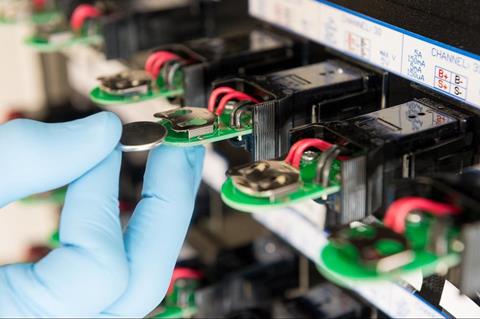Researchers from University of California, Berkeley, have concluded that battery prices of US$100 kW/h make the electrification of trade routes of less than 1,500 kilometres economical.
Battery-electric propulsion is an attractive alternative to e-fuels, they say, because studies have indicated that the total cost of ownership of bulk carriers running on e-fuels would be 200-600% higher than that of running on HFO.
“Lithium iron phosphate (LFP) batteries are one of the chemistries to undergo electrochemical cycling performance testing at ANL’s Battery Laboratory.” “/ / 
Source: Argonne National Laboratory
Lithium iron phosphate (LFP) batteries are one of the chemistries to undergo electrochemical cycling performance testing at ANL’s Battery Laboratory.
Previous studies on the costs of batteries have not taken recent reductions in cost and improvements in energy density into account. Today’s best available technologies have a specific energy of 210 Wh/kg and cost US$100 for 134 kW/h.
While batteries add weight compared to an internal combustion engine, affecting draught, the power increase required to account for this is less than 10% for voyages of less than 5,000 kilometres. For a small neo-Panamax container ship, the volume required would be less than that currently dedicated to a combustion engine and fuel tanks for voyages under 3,000 kilometres. For routes of 20,000 kilometres, the battery would occupy 2,500 TEU, about a third of the vessel’s cargo carrying capacity.
The researchers considered eight container ship sizes sailing on 13 major routes. They limited their analysis to lithium iron phosphate (LFP) batteries as they believe that the high charge rates and long lifecycles of this chemistry would suit shorter, more frequent voyages for vessels with lower power requirements.
The total cost of the propulsion system is lower than that of an internal combustion engine for ships larger than 8,000 TEU over voyages of less than 1,000 kilometres. If the environmental costs of CO2, SOx and NOx are included, the cost becomes attractive over ranges of up to 5,000 kilometres across all size classes of vessel. To cross the Atlantic or Pacific Oceans, battery prices need to reduce to US$20 kW/h before it is cost effective, although re-charging at chokepoints such as the Suez Canal, Strait of Gibraltar, Strait of Malacca and Cape of Good Hope offer the potential for recharging while vessels are queued.
However, the researchers point to developments such as iron-air batteries that are far cheaper than current lithium batteries.
The paper is available here.





